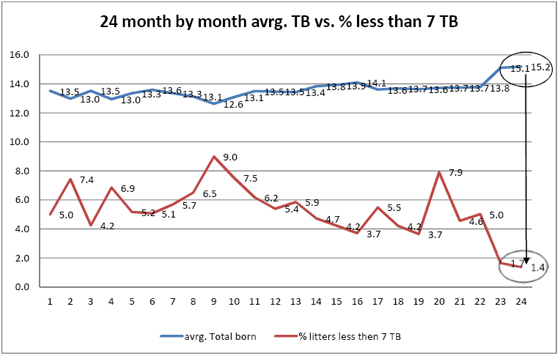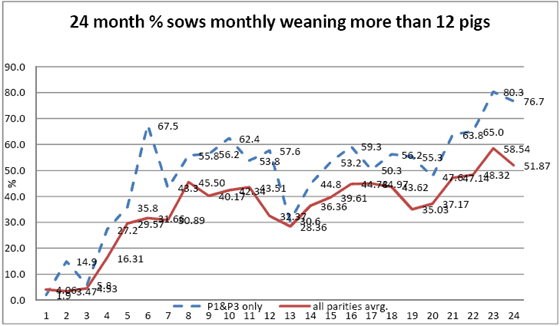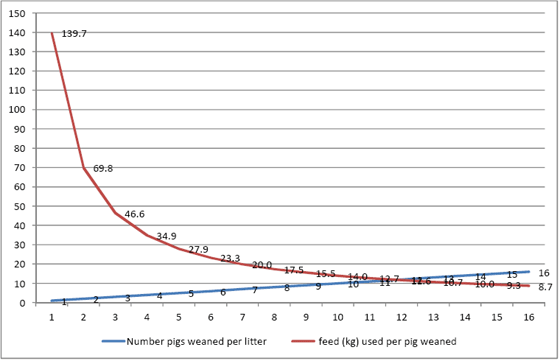



Pioneering New Performance Indicators
In his presentation to the 2013 London Swine Conference, Egidijus Mickevicius (Technical Services, Canada, Hypor Inc.) focused on two new key performance indicators - the percentage of litters with fewer than seven piglets born and with 12 or more piglets born. These measures have important implications for feed costs per piglet weaned.
Over the last decade, significant advances have been made in sow productivity around the world. We are also starting to learn and realise differences in sireline fertility.
Academic papers, commercial benchmarks, genetic trends and other industry statistics point to the same fact – our breeding herds are becoming more prolific, productive and in many cases more efficient. And although there are many ways to measure sow productivity, the author's experience has been that most farm production service visits will be focused on five key performance indicators (KPIs) when benchmarking and measuring improvement over time:
- Farrowing rate
- Total born and born alive
- Pigs weaned per sow
- Piglet survivability
- Pigs weaned per mated female per year (PWMFY).
Listed below is a combination of most common and “new” KPIs for your review. The author asks you to put aside scepticism and open your mind to take some time to review and compare what some of your neighbours are looking at and the performance their herds are achieving.
- Total Born (TB) = 14+
- Born Alive = 13+
- Weaning over 11.5+ pigs per litter
- Farrowing rate over 90+ per cent
- Wean to Service Interval = 5.5 days
- per cent sows bred by 7 days 95 per cent
- per cent litters less than 7 TB = 3-5 per cent
- 50 per cent of young sows P1, P2, P3 weaning 12 or 13 piglets
- per cent of all sows weaning more than 12 pigs = 35+ per cent
- Pigs weaned sow lifetime = 55+
- Total pigs weaned before P4 = 33-36
Over the last few years, the author says he has been very fortunate to work with some of the best producers and pork production systems in the industry. Being the best is usually the result of challenging the status quo and doing things differently, so working with the best has provided me with a great opportunity to learn, take me out of my own comfort zone and develop new ways of thinking.
Some questions that have come out of meetings with these top producers include:
- Why is there so much litter size variability from my most productive sows?
- Why are some of my sows weaning 12, 13, 14 piglets and others are not? Review Table 3 for an explanation.
- Is our breeding timing off?
- Are we missing heats?
- What is the impact of Boar Fertility on litter size and litter size variability ?
- Are sows are coming to heat after weaning sooner than “normal”?
- Where can we focus, cost-wise, to produce pig more efficiently?
Before wrapping our minds around answering these questions and developing action plans in pursuit of new goals, it is essential that we are able to track the results of any changes we implement and for this some new KPIs can be very useful tools.
In this short summary the author focuses on two KPIs that he sees as “NEW, different and unique”. Most pig production software programs on the market today will report:
- percentage of litters with fewer than seven total born and
- percentage of sows weaning more than 12 pigs.
What does Chart 1 demonstrate?
Chart 1 represents a 2,500-sow unit’s last 24 month-by-month averages, total born and per cent of litters with less than seven total born. Months 23 and 24 are showing particularly interesting trends.
Percentage of litters with less than seven total born – several farms are reporting observations that there are certain sirelines that are capable of producing more piglets than others. Research at the University of Alberta (J. Patterson et al.) have demonstrated in recent North American trials that there are significant differences in boar fertility.
Could you imagine how happy farrowing people would be if every sow would farrow with minimal variability of piglets born (some of the best producers are reporting less than seven total born at two to three per cent of litters farrowed).
What does this mean? From practical point of view it means:
- less fostering
- less disease cross-contamination
- less litter growth disruption
- lower labour (hours per sow farrowed) to get litters started and
- more healthier and heavier piglets at weaning
Chart 1. Month-by-month averages for total born and per cent of litters with fewer than seven Total Born (TB), for a 2,500-sow unit

What does Chart 2 demonstrate?
Chart 2 demonstrates the sows’ ability to wean piglets based on their udder capacity.
As we continue to challenge sows to wean more piglets, the goal should be to pay close attention at selection time to ensure we have only the best gilts delivered to the gilt development unit.
Farmer et al. (2012) clearly demonstrated that teats that were suckled in first lactation produce more milk and have a greater development in the second lactation than non-suckled teats. In other words, better mammary stimulation and development on the first and second lactations mean the better will be sows ability to wean large uniform litters.
Chart 2. Percentage of sows weaning more than 12 pigs

What does Chart 3 demonstrate?
Chart 3 demonstrates the feed cost per piglet weaned. What is clear is that feed cost decreases if sows are capable of weaning more piglets.
Assuming $0.40 per kg lactation feed cost and 6.7kg daily consumption × 21 lactation days = $56.
The difference in this example is $1.56 per piglet weaned (Table 1).
Chart 3. Feed cost per piglet weaned

Table 1. Feed cost per pig weaned at different litter sizes

Conclusions
As the industry continues to operate under the pressure of higher input costs, the challenge upon on everyone is to do more with less. We are all aware of feed cost trends and one way to offset increased (isowean piglet) cost of production is to wean more quality pigs with fewer sows. We can see that these difficult market conditions are making us think differently (cost vs. production interaction serves as a base for discussions) and it is motivating to be part of brainstorming sessions at the kitchen table of some of the very best industry minds, where new business and management ideas are discovered.
The author thanked all the producers he had the opportunity to work with in discussing and learning about new KPIs, implementing them, and extracting performance evaluations once management practices surrounding those KPIs were executed. He acknowledged that those that work on those new management techniques are satisfied with their accomplishments.
Acknowledgements
Ontario producers, Jennifer Patterson - University of Alberta, Ontario Pork, Magapor, Cronin Farms,
Genex Ontario, Hypor Inc. (a Hendrix Genetics Company) and PigKnows Inc.
References
Farmer, C. et al. 2012. Milk production in sows from a teat in second parity is influenced by whether it was suckled in first parity. Journal of Animal Science, 90(11): 3743-3751.
July 2013








